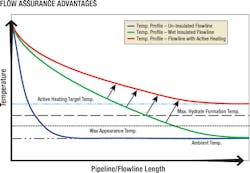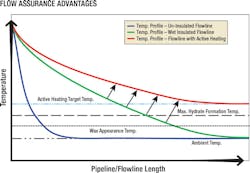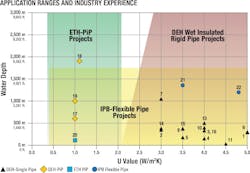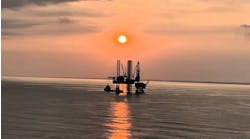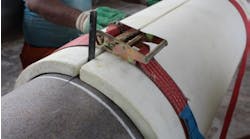Active heating technologies enhance benefits of subsea processing systems
Field architecture can be arranged to reduce capex, opex
Dwayne Duke • Tanaji Dabade • Sriram Subramanian • Rebecca Roth
INTECSEA
The offshore industry is facing an era of increasing challenges not only from reduced oil prices but also the need to develop new methods to reach previously inaccessible reserves. In this context, there currently exists one shared goal among operators: reducing costs. Technological advances are being made today with reduced capex/opex as the driving factor.
On the forefront of innovation, operators are investing in the future of subsea processing with active flowline heating. In alignment with the theme for the 2017 Worldwide Survey of Subsea Processing and Active Heating Systems poster, this article discusses combining the technologies available today and why they are vital to gain access to these unique offshore reserves.
Subsea processing
Since its inception, subsea processing has maintained the primary goal of enabling operators to recover additional reserves by placing pumps and compressors on the seabed near the wells. Secondly, the equipment on the seabed reduces topsides facilities space and weight. Operators have achieved these goals with the help and technology from service companies. Subsea processing technology is considered to be mature as well as field proven. Nevertheless, next-generation iterations are evolving in the form of modularity and compatibility between equipment manufacturers. Operators can significantly benefit from standardization, reducing opex and future field expansions by creating a more competitive environment when selecting manufacturers.
Active heating
The development of deep and ultra-deepwater fields has pushed the industry to develop cost-efficient solutions to mitigate wax deposition and hydrate formation during periods of low production rates and shutdowns, or for use as continuous temperature regulation to optimize production.
The solution is active heating, which combines the function of maintaining an equal, or positive radial temperature gradient across the pipeline contents by manner of electrical current, together with the high thermal efficiency of pipeline insulation, to limit temperature loss in a cold, deepwater environment. Subsea processing shares a common interest with active heating in the form of positioning production facilities on the seabed instead of the traditional approach of using topsides space.
Implementation of this concept decreases size and weight requirements of the topsides, effectively reducing capex. Another reduction in capex can be achieved in the form of eliminating the need for a second flowline used for pigging.
By combining subsea processing with active heating, a long-distance tieback to an existing infrastructure can make a marginal, remote field economically feasible with minimal rework to the platform. To date, these technologies have been applied independently. However, by incorporating them together, operators can maximize the potential efficiency of developing an offshore field while furthering cost savings.
Active heating technologies
Active heating technology is considered to be fairly developed, with the first version of direct electrical heating (DEH) installed as early as 2000 for the Statoil Åsgard project. However, next-generation active heating systems are proving that lower power requirements and higher efficiency are possible. Subsea processing is also a very mature and field proven technology, with installations now circling the globe with a high level of reliability. Some of the key technology types are described below.
Direct electrical heating. This is the earliest of the active heating designs, and as a result is the most field proven technology. In the single pipe/wet insulated system, electrical current is transmitted via a platform-supplied riser cable and contains two conductors, one connected to the platform end of the pipeline and a second connected to a piggy back cable which is secured to the outside of the pipeline. Current is transmitted through the piggy back cable, which is connected to the pipeline end furthest from the platform, then travels through the pipe wall back toward the platform. In the Pipe-in-Pipe (PiP) DEH system, the electrical current flows in the outer pipe wall, is transferred to the inner pipe via a conducting bulkhead, and then flows in the inner pipe wall. The PiP electrical connections are made either on the host facility (end-fed system) or subsea using wet-mate power connectors (center-fed system). In both DEH system architectures, the pipeline steel acts as a resistor, heating the contents to a target temperature.
Electrical trace heating pipe-in-pipe. This is the latest evolution of active heating technology. Benefits include: only one conductor to supply power (no return to platform); cost saving through decreased power consumption compared to DEH; a more uniform heat transfer and greater thermal efficiency by means of an insulation medium which fills the void between the outside and inside pipes. Although there are only a limited amount of these in service, they are proving to be the choice of operators when PiP flowlines are planned for future field developments.
Integrated production bundle.When used in conjunction with actively heated flowlines, IPB risers provide the link to create a continuously heated system from well to platform. IPB risers allows for a more uniform temperature of the pipeline contents, and solve the issue of significant heat loss to the environment as well as pressure decrease from the seafloor up to the platform. In addition to providing active heating, integrated production bundles can also provide a means to handle gas lift when required.
Active heating benefits
Historically, intervention methods such as chemical injection, circulation of dead oil and depressurization have been used to solve deep and ultra-deepwater flow assurance issues. Active heating avoids the need for chemical injection, fluid circulation, storage and heating facilities. These advantages complement subsea processing in relocating topsides facilities to the seafloor. The specific benefits relating to subsea processing with active heating are listed below.
- Alternative to chemical injection
- Allow longer tiebacks
- Flow assurance reliability
- Reduced topsides equipment handling
- Reduced HSE exposure to chemicals
- Reduced environmental risk
- Improved reservoir production capabilities
- Reduced production start-up interval after shutdown
- Reduce or eliminate chemical injection opex
- Reduce capex by eliminating pigging riser/flowline
- Gain economic feasibility for remote marginal fields.
Field development
INTECSEA has identified all projects that have installed active heating, which can be found in Table 5 of the 2017 Worldwide Survey of Subsea Processing and Active Heating Systems poster. There are a few developments deemed noteworthy as they represent the principle of this article: those which over time have incorporated both subsea processing and active heating.
The projects described above are as follows; Statoil Åsgard in the North Sea, Shell Ormen Lange also in the North Sea, and Shell Serrano/Oregano in the Gulf of Mexico.
Industry trends
For deep and ultra-deepwater fields, the trend remains of reducing topsides real estate requirements for equipment associated with operating subsea fields. This holds true for subsea processing, as well as the application of active flowline heating. The development of remote marginal fields can be realized by advances made in these two technologies, especially when considering tiebacks to existing brownfield infrastructure. By combining the two field proven technologies of subsea processing and active heating, the field architecture can be strategically arranged in such a way to achieve the vision of reduced capex and opex for offshore developments. The combination of these two technologies presents a cost effective and environmentally friendly field development option with the promise of continuous evolution through industry alliances and investment in joint industry projects.
Subsea processing poster
This issue ofOffshore also contains the 2017 Worldwide Survey of Subsea Processing and Active Heating Systems, the tenth installment of this industry resource. The primary aims of this poster are to chronicle the development and developers of these systems, and to document the continued commitment of oil companies to the application of these technologies.
For online access to view and download all 10 posters, please visithttp://www.offshore-mag.com/maps-posters.html.
